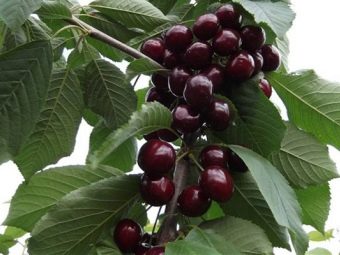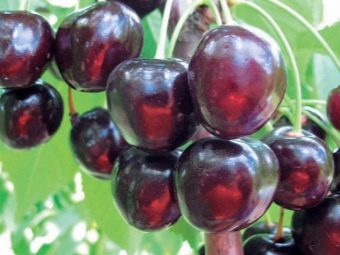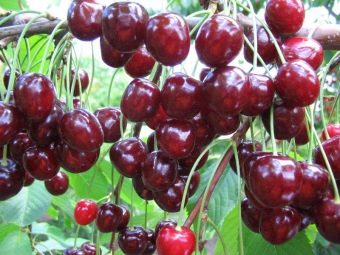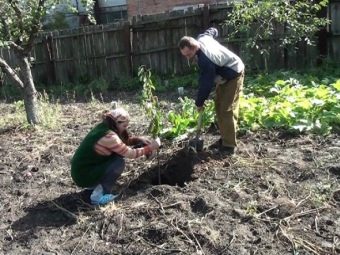Sweet cherry is a berry or fruit, types and the description of popular grades
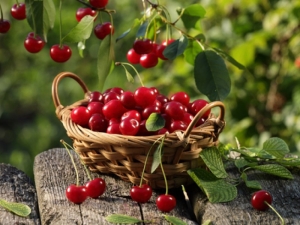
Cherry is called the pioneer of the berry season. These trees belong to the Rosaceae family, to which cherry, apple, pear and peach also belong. Since ancient times, sweet cherry has grown in Asia and Europe, and at the end of the 19th century, thanks to the efforts of the Russian breeder Timiryazev, it began to spread throughout the territory of modern Russia.
Features of culture
Sweet cherry is loved both by children and adults, they eat it fresh, and also it is prepared for winter in the form of compotes, added to pastries and cold desserts. However, many can not answer the question whether the cherry is a berry or is it a fruit. In scientific literature it is customary to use the term “fruit” —that is, the part of a plant that forms from a flower ovary, including seeds or seeds. In everyday life, fruit means large fruits that grow in gardens, and berries - small, juicy flesh and more or less rounded. Berries often grow on bushes in the wild and can be eaten by handfuls.
The concept of a sweet cherry is a moot point because it has signs of both fruit and berries., but nevertheless, according to the totality of signs, it is more expedient to rank it as fruit. However, in everyday life the word berry in relation to it is quite appropriate, for example, in the phrase "several berries of a sweet cherry."
Species description
Cherry trees differ in numerous characteristics. We give some classifications of varieties.
Self-fertile
They form the ovary, even if there are no other pollinating trees nearby. Thus, the gardener may not plant too many different varieties, which is especially important if it is small in itself. Among these varieties there are many new products, which also have a number of other advantages of modern breeding.
Winter hardy
Such varieties are always in demand outside the Black Soil Region. It is not surprising that for the first time they were bred in Leningrad, where weather conditions previously did not allow planting this heat-loving culture. Selection work continued in Bryansk, where they learned to grow more cherry-resistant cherries, and their taste was improved. Today they are actively cultivated and have many varieties, including "Bryansk Rose", "Iput", "Ovstuzhenka", "Revna".
Kolonovidnye
Cone-shaped cherries are becoming more and more popular every year, especially in regions with a temperate climate. Its appearance is different from the usual gardeners trees - it has a cylindrical shape, grows only upwards, has very short side branches - the diameter of the crown is about a meter.
An important advantage of such varieties is that in the winter they are not difficult to protect from adverse weather conditions. In addition, they are easy to care for, no need to pay special attention to the crown. Gardeners usually do not have difficulty in reproducing such trees and harvesting. The first fruits can be collected in the same year as the new sapling was planted.
Advantages of the columnar cherry.
- Decorative. Trees look almost the same, which allows you to maintain a neat view of the site, without disturbing the overall landscape design.
- Compactness. Due to the modest dimensions of these trees, they can be planted in a small area. They are also easy to process and harvest from them.
- Skoroplodnost. The maturity of different varieties continues from the beginning to the end of June and makes it possible to enrich the diet with vitamins already in the first days of summer.
- Taste qualities. The fruits of these varieties are praised for the rich and pleasant taste, which breeders were able to maintain despite the fact that the main emphasis was placed on other qualities.
Usually seedlings of the columnar cherry have an even stem with smooth bark. When choosing, pay attention that the apical bud was alive, there was no rot on the roots, and the leaves (if any) were free from damage.
Top Grades
"Bryanochka" is a hybrid of "Red dense" and "8-14."He was bred by the famous breeder Kanshina in 2006. The length of the trees is up to 3.5 meters, the branches are rare and slightly spreading, so the berries get more sun. The fruits ripen in the second half of the summer, the seedlings bear fruit in the fifth year. For fruiting needs such neighbors as "Veda", "Iput", "Tyutchevka".
The average weight of the berries is 4.5 grams, maximum 7. In shape, they resemble hearts, slightly flattened. “Bryanochka” is a rather sweet variety, besides, the pulp of the berries is rather firm.
"Valery Chkalov" Bred in the USSR in 1974. During the years of growth, the length of trees reaches 6 meters. The shape of the crown resembles a pyramid, and with age, branches intensively grow in all directions and it acquires a rounded cap, the diameter of which can exceed 6 meters. The cherry starts to ripen in 5-6 years, brings the first harvest up to 17 kilograms from a tree, and in old trees this figure reaches 60 kilograms. The shape of the berries is heart-shaped, the size is rather large, the color is from dark red to black, and the weight is from 6 to 9 grams.
Bone and peduncle sit tight. You can get the first berries in early June. Trees winter well even at a temperature of -30 and at least part of the buds necessarily bear fruit. Fungal diseases can damage a tree, especially it is prone to gray rot.
"Vasilisa" - This is the largest sweet cherry from the varieties described by us. She was the result of crossing the “Donetsk coal” and the “Donetsk beauty”. Berry weight - up to 14 grams. Trees grow up to 4 meters, but it is better to control this process and not let the branches get too stretched. Shoots can be bent, crown has a rounded shape. Winter-hardy, tolerates drought, fruitful. The fruits are not just sweet, but with a subtle wine flavor, a small stone is easily extracted. The flesh crunches slightly.
You can pick berries in the second year of planting in June, and under adverse climatic conditions a little later. Each mature tree gives up to 50 kg of harvest in a good year. If summer is not pleased with the weather or the tree has received less nutrition, then the harvest may be lower - about 30 kg of berries. A good option for growing for sale, as this sweet cherry keeps the presentation well during storage and transportation, it is excellent for the production of compotes.
Variety "Veda" breeds only with pollinators, the late Leningradskaya Chernaya, Revna, Tyutchevka, Ipul, Bryanochka are best suited for this. As a rule, it bears fruit at the junction of June-July. Up to 30 kg of berries are harvested from each tree.
It does not tolerate drought, and especially needs regular watering, and it can survive frosts quite well. Weakly protected from diseases and pests.
To prevent trees from dying, they are recommended to be sprayed with special solutions.
Variety "Favorite Astakhov" bred by Kanshina, he officially entered the registry not so long ago - in 2011, and the variety was given this name in honor of the husband of the agronomist. He does not like wind and marshy land, and if there is a risk of flooding the land, then it is better to plant it on a dumping hill. The height of a sweet cherry is up to 4 meters, the crown is spreading, they make it round. Has established itself as a variety suitable for cultivation outside the Black Soil Region.
Despite good frost resistance, young seedlings need to be sheltered from the cold, and adult trees in regions with a cold climate need care. The crop appears on the fifth year of growth. Samoplodna partially - in the presence of trees of other varieties gives more ovaries. Brings up to 10 kilograms of berries from each tree. Almost black berries have an average weight of 5 grams, keep their shape well during storage and transportation. Truly outstanding flavoring properties allowed "Lyubimitse Astakhova" to have one of the highest tasting ratings.
Sweet cherry "Julia" enjoys success in the Moscow region, Bryansk and nearby cities and villages. The height of the bushes 7-8 meters, tolerate frost well.The average weight of each berry is 5 grams, the shape is slightly flattened, round, there is a blush.
Lasts on the junction of June and July, well transports transportation for sale in other localities.
"Ovstuzhenka." They like to cultivate this sweet cherry in areas with a not hot climate. These are rather low trees that quickly reach the final level of growth. The crowns have a rounded shape. The fruits are oval or round, the color is dark, and at the end of ripening they are almost black, their weight reaches a maximum of 7 grams.
From one tree, gardeners manage to get 15 kilograms of berries. It reproduces beautifully in the society of such neighbors as “Revna”, “Tyutchevka”, “Raditsa” and “Iput”.
Tyutchevka, as well as Revna, Ostuzhevka, Is a popular variety due to its compatibility with varieties that do not bring ovaries in the absence of pollinating trees. She is advised to plant the gardeners of the southern Black Earth. To make the ovary trees, pollinators are needed. The Ovstuzhenka, Raditsa and Iput varieties cope well with this. Fruits late, brings up to 15 pounds of fruit. Trees srednerosly well tolerate cold. Able to withstand many diseases, detrimental to weaker varieties.
This cherry is characterized by small fruits up to 5 grams in weight. The core is firmly seated in the pulp.
Easily transported over long distances and keep their shape well after freezing.
"Revna" able to take root in various regions of Russia. Trees are able to pollinate themselves, but the best results are shown in alliance with “Ovstuzhenka”, “Iput”, “Tyutchevka”. Differs in good fertility - up to 30 kg of berries from a tree. “Rev” was appreciated by tasters and gave it a rather high mark - 4.9 points for taste. Also, the variety is able to survive in the winter, not to get sick with the ailments typical for fruit, it carries the transportation to other settlements and frosts. Gardeners often point out such an important quality as the ability to resist sunburn.
Mid-season "Revna" has a particularly wide funnel with a round top and a mass of 6 grams. The first berries can eat in early July.
Fatezh. The growth of the trees of this “Muscovite” is modest, but they have an unusual rounded and at the same time sprawling crown. First, shoots grow straight, and later begin to sag. It bears fruit well with “Krymskaya” and “Chermashnoy”.
Fatezh is characterized by extreme resistance to cold weather, sometimes even tree flowers carry the winter. It differs in good ability to resist diseases. The mass of berries is about 4 grams, the shape is round. The fruits are not just sweet, but sour. A small minus can be called moderate fertility "Fatezh" - mature trees give 25 pounds of crop.
Loved by many variety "Iput" appeared after breeding varieties "3-36" and "8-14." From various hybrid seedlings for a long time selected the most worthy. In 1993, it was officially introduced and recommended for planting. Since then, "Iput" safely planted in a temperate climate. This name he received in honor of the river Iput, which flows near Bryansk, where selection work was carried out.
The color of the Iputi fruit varies from red to maroon black, and the more ripe the fruit, the darker it is. The average weight of berries is 5 grams, but there are also giants up to 9 grams. The disadvantage can be called such a feature of the fruit, as the cracking of ripe berries while in the rain. For the unique taste of the flesh received recognition from gourmets.
"Chermashnaya" berry - sredneroslaya, one of the pioneers of the berry season. It is possible to try its berries for 3-4 year of growth. Berries "Merry" light yellow, almost white. Like most light grades, it has a peculiar sour taste. The fecundity of this variety can not be called high, it usually ranges from 15-20 kg per bush. Absolutely non-self-fruiting variety.For the appearance of ovaries, Fatezh, Raditsa, or Bryansk Pink are needed.
The ability to survive in the cold in this class is average, not all buds wait for climate fluctuations in the offseason. It really takes root in the southern regions and in the Black Earth region. Enthusiasts are trying to plant it in the middle lane, but according to reviews of gardeners, the bark of these not very resistant specimens can be damaged by frost, so the harvest here is not always happy with impressive volumes.
"Bull's heart" - these are trees in the shape of a pyramid, the crown is easy to form. Winter-resistant variety is able to withstand in extreme cold, but not stronger than -25 degrees. “Bull's heart” is valued primarily for large fruit sizes (up to 8 grams). This is an impressive result not only for the Russian, but also for foreign breeding, because there are only a few varieties with “giant” fruits - less than 10% of their total number.
It has good tasting qualities, it has a sweet taste, slightly sour, but does not preserve its marketable appearance during transportation. Moreover, the berries often crack when they ripen, which is associated with climate fluctuations.
"Dyber black" - famous for its high fecundity. The first berries can be removed at 4-5 year of growth, but this is up to 10 kg of sweet cherries. Ten-year-old trees make it possible to get simply excellent yield - up to 60 kg of cherries, and if you count the total fee per hectare of a plot, you will get 90 centners. 6.5 grams of berries are a pretty good indicator. In the process of ripening, they turn black, have a very strong smell and sugar taste.
It carries a good transport over long distances, has excellent external characteristics even a few weeks after their collection. Overripe fruits sometimes crack only from rain.
"Italian". Despite this name, it is a Russian variety, which was the result of breeding work on the crossing of "Glory of Zhukov" and "Bigarro." The tree has modest dimensions, a round cap and a neat shape. This is a large-fruited sweet cherry, its fruits are rather voluminous, their weight is 6.5-8 grams. Not too demanding for irrigation and temperature conditions. Steadily fruits and allows to receive 80 centners from hectare.
For its simplicity and versatility "Italian" fell in love with the gardeners who grow it for sale. Only in this case it is better to be engaged in sales in your city or region, since it does not work well for transportation - after a few weeks it starts to rot.
Color variety
When choosing cherries, many are guided by such a parameter as color. Someone seems to be the best berry of dark shades, someone, on the contrary, more like light. Classic dark red varieties also have their fans. With such a color variety it is easy to get confused, and you want to know your favorite varieties "by face".
If you want to navigate in varieties on this parameter, then this information will be useful to you.
- Black berry reaches the most saturated color after reaching technical maturity. These are “Adeline”, “Bryanochka”, “Veda”, “Iput”, “Ovstuzhenka”, “Revna”, “Raditsa”, “Tyutchevka” varieties.
- Yellow cherries ripen early and do not tolerate transportation. These are “Drogan yellow”, “Red dense”, “Home yellow”, “Chermashnaya”.
- Pink berry - “Fatezh”, “Bryansk Pink”, “Leningradskaya Pink”.
- Orange - "Pink Pearl".
By ripening time
As is known, there is a sweet cherry tree, which is able to please berries even in spring, and the late "sisters" give the first berries, when the good half of summer is over. Early berries are usually not transported. Note that medium grades are ideal for roll-in. July grown under the bright sun, have time to collect sweets and juice, good for the production of dried fruit and jam. Choosing seedlings for their backyard, gardeners wonder what the time for harvesting of certain trees.This is especially important if we are talking about non-self-fruited specimens that need pollination by other varieties. Their flowering time should be as close as possible to each other.
Let us consider in detail the classification of sweet cherries according to the time of ripening.
Early
They allow you to enjoy the wonderful taste of cherries and get a portion of vitamins and minerals when the body is tired after a long winter. This is a very valuable quality, so gardeners tend to get a couple of these varieties. Often their names speak for themselves.
These include:
- "Early Mark";
- "Valery Chkalov";
- "Early Duki";
- "Rapid";
- "Home May".
Average
Typically, these specimens bear fruit at the junction of the first two months of summer and actively continue the cherry season.
These are varieties such as:
- Abigarro;
- "Vasilisa";
- "French large-fruited";
- "Donchanka";
- "Sylvia";
- "Oryol pink";
- "Caucasian";
- "Kuban".
Late
According to the tradition, sweet cherry opens the fruit season in summer, but thanks to these varieties one can enjoy its taste during the whole warm period. By the way, it is late varieties, as a rule, that are characterized by increased winter hardiness. This is appreciated by gardeners living in an uncomfortable climate zone.
These include:
- "Dniprovka";
- "Leningrad black";
- "Bryansk Pink";
- Tyutchevka;
- "Regina";
- "Raisin large-fruited."
For the Leningrad region and the Moscow region
Developed for these areas and the nearest localities, cherries are able to survive even in fierce winters, gradually adapting to a decrease in air temperature and precipitation. If a particularly cold year is issued, and even with temperature fluctuations, not all trees remain in the ranks. The krone is especially vulnerable to cold weather when there is no snow on it. It is also important that the temperature in different layers of air is different - at the snow edge it is 10 degrees lower than in the region of the top. All this undoubtedly represents a stress for the trees.
On which varieties of cherries dwell on the inhabitants of the middle lane - there is no single answer to this question. Breeders have different points of view on this, but we will try to summarize the information on this topic. According to gardeners, in the harsh winters they were most pleased with the Odrinka, Revna, Ovstuzhenka, Bryansk Rose and Veda varieties. They not only survive in any weather, but also receive minimal damage to the wood. Other varieties are also allowed in these regions, but in order not to make vain efforts, it is worth exploring the experience of other gardeners.
For Siberia
In order to settle down and produce crops in the conditions of the Siberian cold, sweet cherries must have increased winter hardiness of buds. All other properties, such as high tasting qualities and compact dimensions, in this case go by the wayside. For these latitudes, breeders recommend “Bryansk Rose”, “Odrinka”, “Revne”, “Rechytsa”, “Tyutchevka”.
The peculiarity of sweet cherry growing beyond the Urals is its height. This feature affects the yield, so this phenomenon has to fight on their own. Gardeners carefully control the growth of the tops and shorten it. If you overdo it and cut off too much when forming a crown, then the trees may not suffer such an execution. The most tolerant of such a procedure can be called the variety “Ovstuzhenka”.
In total, 14 varieties of cold-resistant cherries have been developed and introduced by Russian specialists, 10 of which were the fruits of the works of breeder Marina Kanshina.
Gardeners usually practice both autumn and spring planting of trees, but the Siberian climate somewhat limits their choice of planting time. It is recommended to plant these heat-loving trees only in spring, so that the seedling can take root in a new place before the onset of the cold season.The southern slopes of hills and hills near large bodies of water are most suitable for these purposes. On sites should be as little as possible cold wind. This will have a positive effect on the microclimate, that is, on air temperature and humidity.
There are also peculiarities of growing cherries in regions with a cold climate. Lateral branches are pruned immediately upon completion of planting, but the main pruning is carried out the following year in early spring. At the same time get rid of all the dried up, uneven shoots. The height of the tree is also shortened after the appearance of the first five buds. Often, the drifts in Siberia are so high that small seedlings can safely winter in them, sheltering from frost.
Interesting Facts
Cherry has a different name - Bird Cherry, and it refers to the genus Plum.
- Sweet cherry was known at least 8000 years BC. e. on the territory of modern Denmark and Switzerland.
- By consuming 100 grams of this delicious fruit daily, you can get rid of iron deficiency anemia.
- The largest cherry trees sometimes grow to the level of 25-30 meters.
- From cherries get food dye green.
How to increase yields?
Many are already familiar with the basic rules of growing such a thermophilic culture as sweet cherry. They help to achieve the best results in your area. Armed with this knowledge, the chances of success in such painstaking work are enhanced.
Keep in mind that winter-hardy cherries, designed for harsh conditions, are most often self-infested. For successful work, summer residents and owners of personal plots have to start at least two different varieties. In this case, the rule “the more diversity the better”. However, the neighborhood must be effective, that is, you need to combine trees with similar periods of formation of ovaries.
If you ignore this simple rule, the plants will not receive good pollination. As an option, planting only one sweet cherry in oneself, one can wait until it grows and plant other varieties in the crown.
Groundwater should not be closer than 1.5 m from tree roots. Perfect for them elevated and dry areas. Drainage will help to cope with flood waters.
It is necessary to make indentations up to 80 cm around the cherry plantings.
For such a tree, weakly acidic soils are good, but if this figure is too high, then the sweet cherry will not please you with high fertility. Create a more comfortable environment in this case will help lime. For light soil, it will take up to 400 g of compound per meter, and for heavier ones - up to 800. After the first liming procedure, it will have to be repeated once every four years. In the offseason, it is thrown under the trees, and then dug up the ground.
Young specimens are actively growing. Not only that too long tops do not give fruit, they also increase the risk of freezing trees in the cold season. You can not wait for spring and remove the extra centimeters in the summer. These are dry, crooked and too long shoots. Then the tree will not go up, but in breadth. Short branches give more buds, from which fruit ovaries are formed.
Summing up, we note that the selection of varieties of sweet cherries is a painstaking exercise, but very important for obtaining truly impressive results. Everything depends on the priority requirements for each gardener: frost resistance, ability to resist fruit tree diseases, yield, ability to independently bear fruit regardless of whether there are other varieties on the site, desired height, etc. Having learned all the details of sweet cherry growing in your region , you will definitely get a good harvest, even if you live in a not very warm region of the country.
On how to properly plant and care for cherries, see the following video.








